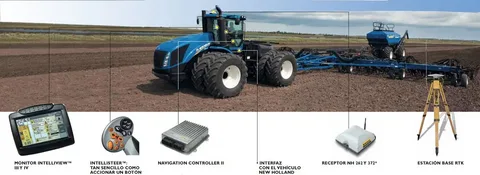Modern agriculture is experiencing a technological revolution, and one of the key innovations transforming farming practices is GPS-based tractor guidance system. These systems are helping farmers optimize field operations, reduce waste, and ultimately improve crop yields. In this article, we’ll explore how these systems work and the benefits they bring to modern farming.
What Are GPS-Based Tractor Guidance Systems?
GPS-based tractor guidance systems are advanced technologies that use Global Positioning System (GPS) signals to guide tractors and other farm machinery precisely across fields. By leveraging satellite positioning, these systems can track tractor movements in real-time, allowing for accurate planting, fertilizing, and harvesting operations.
Unlike traditional methods that rely on manual steering and visual cues, GPS-guided systems ensure straight lines, even spacing, and efficient coverage of fields. This precision significantly reduces overlaps and missed areas, which can directly affect crop productivity.
How GPS-Based Tractor Guidance Systems Improve Crop Yields
1. Precision in Planting and Fertilization
Accurate planting is crucial for achieving uniform crop growth. GPS-based tractor guidance systems allow farmers to plant seeds at the exact spacing and depth required for optimal growth. This precision reduces overcrowding and ensures that each plant receives sufficient nutrients and sunlight, leading to higher crop yields.
Similarly, these systems enable precise application of fertilizers and pesticides. By avoiding over- or under-application, farmers can maintain healthy crops while minimizing chemical waste, which also benefits the environment.
2. Reduced Soil Compaction
Repeated tractor passes over the same area can lead to soil compaction, which hinders root growth and reduces crop yields. GPS guidance helps create efficient routes for machinery, minimizing unnecessary passes over the field. This not only preserves soil structure but also promotes healthier crop development.
3. Time and Resource Efficiency
By automating guidance, farmers can complete tasks faster and with fewer errors. GPS-based tractor guidance systems optimize fuel use, labor, and time, ensuring that operations such as planting and harvesting are completed under ideal conditions. Timely operations prevent crop stress and loss, contributing to improved yields.
4. Data-Driven Farming
Many GPS-based systems integrate with farm management software, allowing farmers to track field performance and adjust practices based on data. By analyzing trends and outcomes, farmers can make informed decisions that maximize productivity year after year.
Conclusion
The adoption of GPS-based tractor guidance systems is revolutionizing modern agriculture. By enhancing precision, reducing soil compaction, and optimizing resource use, these systems play a crucial role in improving crop yields. Farmers who invest in GPS-guided technology gain not only higher productivity but also greater efficiency and sustainability in their operations.


